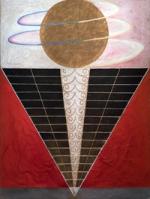Group X, No. 2, Altarpiece
Hilma af Klint
Hilma af Klint Foundation
Stockholm, SE
1915
When Hilma af Klint (1862–1944) embarked on her journey of creating radically abstract paintings in 1906, they represented a bold departure from artistic norms: vibrant, daring, and liberated from any recognizable references to the physical world. Her avant-garde compositions stood as precursors to the groundbreaking works of Vasily Kandinsky, Kazimir Malevich, Piet Mondrian, and others, who would later pursue similar paths of freeing their own art from representational constraints.
Despite the innovative nature of her paintings, af Klint chose to keep them largely private, rarely exhibiting her groundbreaking works. Convinced that the world was not yet prepared to embrace her visionary art, she stipulated that her creations remain unseen for twenty years following her death. As a result, her revolutionary abstractions remained largely hidden from public view until 1986, when they were finally unveiled to the wider world, revealing the profound impact of an artist whose vision transcended her time.
This painting is part of the Altarpieces triptych. The Altarpieces seem to depict a theosophical perspective on evolution that moves in two directions: ascending from the physical realm to the spiritual, and descending from a higher state of being to the material world. In the first two paintings (as seen in the installation view), large triangles symbolize these alternating paths of evolution, while the prominent golden orb in the third piece represents an enlightened state of unity and harmony. Spiraling helixes and colorful rays emanating from the orb convey a sense of progression, while at its center, af Klint incorporates the theosophical symbol of the six-pointed star, rendered in her characteristic colors of yellow and blue.
Type
Oil and metal leaf on canvas
238 × 179 cm
